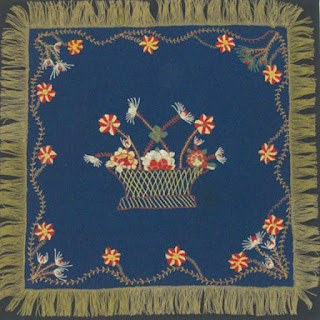Detail of an appliqued table cover by Persis Ripley Bradbury
"Made by P.R.B. 1864."
You may recall seeing this patriotic appliqued piece in the 1994 book Classic Crib Quilts and How to Make Them by Thomas Woodard and Blanche Greenstein, which recorded many of the small quilts that passed through their dealer showroom.
The fifteen blocks add up to a finished size of 27" x 43",
indicating each is about 8" square.
See a digital photo online at the Alliance for American Quilts website Quilt Treasures Presents: Woodard and Greenstein.
Norway, Maine about 1905
Persis Ripley Bradbury was about 30 years old when she appliqued the date. She lived in Oxford County, Maine, near the Vermont New Hampshire border and was married to Henry A.M. Bradbury, who'd been a private in the 23rd Maine Infantry in 1862.
See a post on corrections to this post here:
A view of Paris Hill, Oxford County, from the Robert N. Dennis collection of
Stereoscopic Views
Persis was born in 1835 to Valentine and Lovina Ripley, near Buckfield, Maine. She married Henry in 1855 and when he enlisted he left her with baby Elton and three-year-old Ernest. Two older children Henry and Mary had died at 3 years and just a few days old.
Fortunately Henry's regiment never saw battle although many men died of disease in their service guarding the Potomac and other sites in Washington City, Maryland and Virginia. Persis's brother Eliphaz Ripley died in a hospital in Washington in December, 1863.
The appliqued house
Henry was mustered out in July, 1863, and we hope returned home for the rest of the war.
The family tombstone tells a sad story of Persis's children. Elton died six months after his father returned. Two later girls died young too.
The five children who died before they were five:
Henry Woods, Sept 28, 1856 - Feb. 1859
Mary, May 22, 1858 - May 26, 1858
Elton Bird, Jan. 7, 1862-Jan. 23, 1864 [This date has been misread as 1904.]
Vina Ripley, Feb. 18, 1870-July 18,1870
Inez Pearl, Sept. 13, 1871-Feb. 25, 1873
Children of H.A.M. & Persis R. Bradbury
They seem to have had only one surviving child, Ernest Ambrose Bradbury who became a doctor of homeopathic medicine, practicing in Vermont.
The tombstone was erected when Henry died in 1907.
Persis lived to be 80, dying in 1915. Her family is buried in the Norway Pine Grove Cemetery in Paris, Maine.
In the Woodard and Greenstein book Persis's name is spelled Persius.
(Persis without the U was a rather popular name in that small part of Maine at the time.)
Her small blocks on dark wool have much in common with cotton applique
quilts at the time of the Civil War.
Bed covering dated 1841,
Collection: Museum of Fine Arts Boston
The style is similar to a New England tradition of wool applique, found in large bedquilts.
Wool applique and embroidery on wool, about 1860, 158" x 112"
American Folk Art Museum.
Maine quilt
Collection: Museum of Fine Arts Boston
New England quilt, about 1800-1830. Collection: Winterthur Museum.
And a related tradition of smaller table covers
From Laura Fisher Quilts
Above and below from dealers Elliot & Grace Snyder
Detail of the Bradbury piece, upper right corner.
Details in the Bradbury table clover, such as the blue seam-covering embroidery and the plaid binding (back brought over front?), however, might indicate that the piece was assembled after 1880 when the feather stitch was quite popular.
Here's a detail of a wool applique quilt from the collection of Historic New England. It's
dated 1854 on the right side in one of the blocks. This one is set together in period fashion. Each block was bound before it was joined---a potholder quilt, we'd call it.
See the whole quilt here at the Quilt Index:
In fact, these two quilts have so much in common,
it must go beyond coincidence.
But why I cannot say.























































